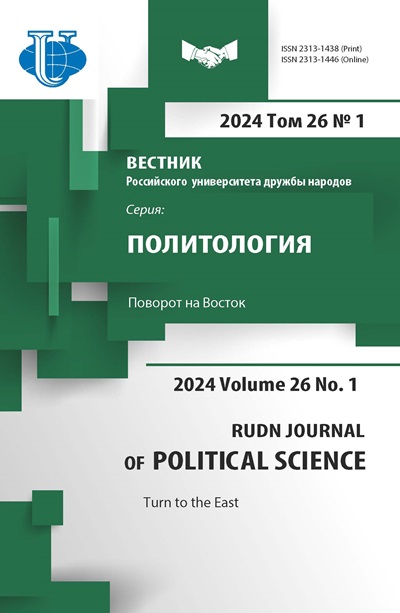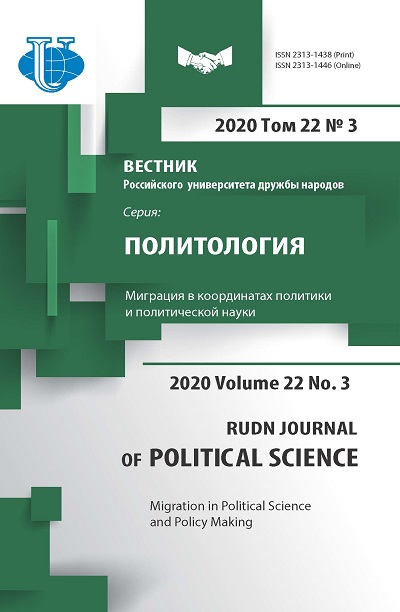Political Future of Migrants in Russia: Hypotheses and Models
- Authors: Savinov L.V.1
-
Affiliations:
- Siberian Institute of Management - Branch of the Russian Presidential Academy of National Economy and Public Administration
- Issue: Vol 22, No 3 (2020)
- Pages: 401-414
- Section: MIGRATION PROCESSES AND INTEGRATION OF MIGRANTS IN RUSSIA
- URL: https://journals.rudn.ru/political-science/article/view/24280
- DOI: https://doi.org/10.22363/2313-1438-2020-22-3-401-414
Cite item
Full Text
Abstract
The political prospects of migrants in Russia are not only an urgent problem, but also require a comprehensive scientific analysis based on the achievements of modern political science. For this reason, the paper attempts to provide scientific and methodological justification and research on the participation of migrants in future political processes. Based on migration dynamics and features of migration behavior, a model-hypothesis - variants and scenarios of political participation of migrants in Russia has been developed. The model includes the following elements: personal and group strategies for the migration future; the trajectory and nature of political participation of migrants; ideological preferences and political attitudes; the content of the political culture of the migration community; the target expectations of migrants in the political sphere; the level of involvement of migrants in civil society institutions; the level of political activity of migrants and leaders of the migration community; the readiness of indigenous people to allow migrants to political processes; the position of the state and government institutions to political claims from migrants. Thus, based on the methodology of contextual instrumentalism, the methodological basis of the political forecast of the future of migrants in Russia is presented, taking into account the basic migration factors and trends, and the main directions of scientific search for ways to verify the formulated hypothesis are also identified.
About the authors
Leonid V. Savinov
Siberian Institute of Management - Branch of the Russian Presidential Academy of National Economy and Public Administration
Author for correspondence.
Email: savinov@siu.ranepa.ru
Doctor of Political Science, Professor, Dean of the Faculty of State and Municipal Management, Professor of the Department of State and Municipal Management
6 Nizhegorodskaya, Novosibirsk, 630102, Russian FederationReferences
- Savinov L.V. Ethnopolitics in the regional dimension: monograph. Novosibirsk: Sibags; 2012. (In Russ.).
- Long-Range Forecasting. 2nd. Ed. by J. Scott Armstrong. 1985.
- Yanch E. Forecasting of scientific and technical progress. Moscow; 1974. (In Russ.).
- Bestuzhev-Lada I.V. Working book on forecasting. Moscow; 2002: 8. (In Russ.).
- Kokoshin A.A. Forecasting and politics. Moscow; 1975. (In Russ.).
- Global community: coordinate system. Ed. by A.I. Neklessa. SPb.; 2000. (In Russ.).
- Ammer M.A. The sociology of migration in American historiography of the late XX – early XXI century. Russian Economic Bulletin. 2019. Vol. 2 (3): 112–116. (In Russ.).
- Heisler B. The sociology of immigration: From assimilation to segmented integration, from the American experience to the global arena. C. Brettell, J.F. Hollifield (Eds.). Migration theory: Talking across disciplines. New York: Routledge; 2000: 77–96.
- Portes A. Immigration theory for a new century: Some problems and opportunities. In C. Hirschman, P. Kasinitz, J. DeWind (Eds.). The handbook of international migration: The American experience. New York: Russell Sage Foundation; 1999: 21–33.
- Brettell C.B., Hollifield J.F. Migration Theory Talking Across Disciplines. Migration theory. London: Routledge; 2014: 13–48.
- Neckerman K., Carter P., Lee J. Segmented assimilation and minority cultures of mobility. Ethnic and Racial Studies. 1999. Vol. 22 (6): 945–965.
- Castles S., De Haas H., Miller M.J. The age of migration: International population movements in the modern world. New York: The Guilford Press; 2013.
- Zhou M. Segmented assimilation: Issues, controversies, and recent research on the new second generation. In C. Hirschman, P. Kasinitz, J. DeWind (Eds.). The handbook of international migration: The American experience. New York: Russell Sage Foundation, 1999: 196–211.
- Bean F., Stevens G., Wierzbicki S. The new immigrants and theories of incorporation. America’s newcomers and the dynamics of diversity. New York: Russell Sage Foundation; 2003: 94–113.
- Collier P. Exodus: How migration is changing our world. Oxford: Oxford University Press; 2013.
- Wachter G.G., Fleischmann F. Settlement intentions and immigrant integration: The case of recently arrived EU-immigrants in the Netherlands. International Migration. 2018. Vol. 4: 154–171.
- Erdal M.B., Oeppen C. Migrant balancing acts: understanding the interactions between integration and transnationalism. Journal of Ethnic and Migration Studies. 2013. Vol. 6: 867–884.
- Zorin Y. The Migration Situation in the Russian Federation: Problems and Solutions. Humanities and Social Sciences. Bulletin of the Financial University. 2019; 9 (3): 40–50. (In Russ.). DOI: https://doi.org/10.26794/2226-7867-2019-9-3-40-50
- Al-Ali N., Koser K. New approaches to migration? Transnational communities and the transformation of home. London: Routledge; 2003.
- Breunig C, Cao X, Luedtke A. Global migration and political regime type: A democratic disadvantage. British Journal of Political Science. 2012. Vol. 42 (4): 825–854.
- McDonald I. Migration and sorting in the American electorate: Evidence from the 2006 Cooperative Congressional Election Study. American Politics Research. 2011. 39 (3): 512–533.
- Russian and world migrations: historical and political analysis (to the 300th anniversary of the creation of migration units of the Ministry of internal Affairs of Russia): Monograph / A.B. Paskachev, V.A. Volokh, V.A. Suvorova. M.: Litera; 2019. (In Russ.).
- Chudinovskikh O.S. Assessing the Scale of Illegal Migration in Russia: Possible Approaches and Sources of Information. Voprosy statistiki. 2020; 27 (1): 8–28. (In Russ.). DOI: https://doi.org/10.34023/2313-6383-2020-27-1-8-28
- Volokh V., Gerasimova I. Management of migration processes in the Russian Federation: analysis and prospects. Upravlenie. 2019; 7 (1): 5–12. (In Russ.). DOI: https://doi.org/ 10.26425/2309-3633-2019-1-5-12
- Huntington S. Clash of civilizations. Moscow: AST; 2003. (In Russ.).
- Sarrazin T. Germany is breaking away: how we are putting our country at risk. Deutsche Verlags-Anstalt; 2010. (In German).
- Buchanan P.J. Death of the West. M.: AST; SPb.: Terra Fantastica; 2003. (In Russ.).
- Liu X., Andris C., Desmarais B.A. Migration and political polarization in the U.S.: An analysis of the county-level migration network. PLoS ONE. 2019. 14 (11): e0225405. DOI: https://doi.org/10.1371/journal.pone.0225405
- Hopkins DJ. The increasingly United States: How and why American political behavior nationalized. Chicago: University of Chicago Press; 2018.
- Tam Cho W.K, Gimpel J.G., Hui I.S. Voter migration and the geographic sorting of the American electorate. Annals of the Association of American Geographers. 2013. 103 (4): 856–870.
- Charyyev B., Gunes M.H. Complex network of United States migration. Comput. Soc. Netw. 2019. 6, 1. DOI: https://doi.org/10.1186/s40649-019-0061-6
- Riazantsev S.V. Modern migration policy of Russia: problems and approaches to improvement. Sociological research. 2019. Vol. 9: 117–126. (In Russ.).
- Kopylov D.A. Migration in the XXI century: challenges to the established world order. Migration and socio-economic development. 2019. Vol. 4 (2): 57–74. (In Russ.). DOI: https://doi.org/10.18334/migration.4.2.41317
















